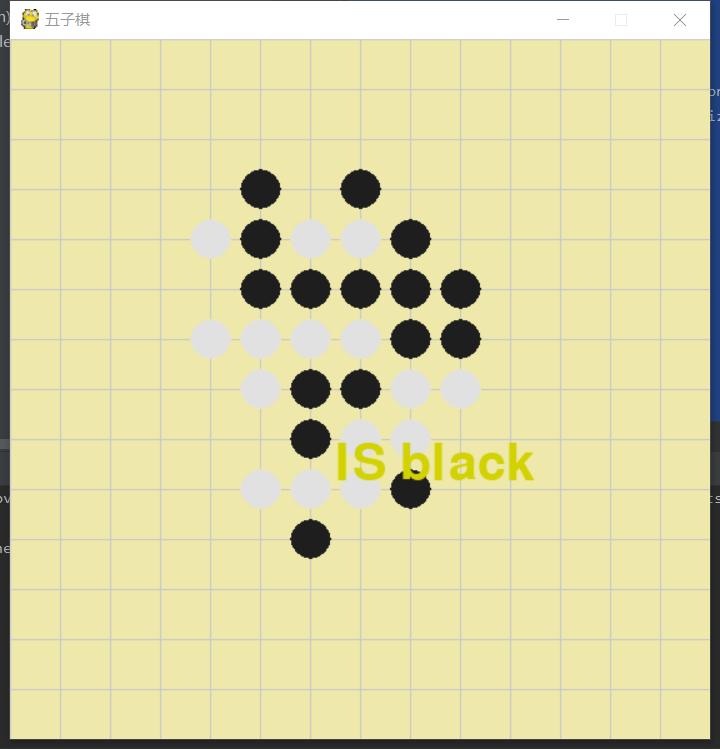20192305 王梓全Python程序设计实验四报告
20192305 王梓全Python程序设计实验四报告
课程:《Python程序设计》
班级: 1923
姓名: 王梓全
学号:20192305
实验教师:王志强
实验日期:2021年6月14日
必修/选修:公选课
1.实验内容
- 1.Python综合应用:爬虫、数据处理、可视化、机器学习、神经网络、游戏、网络安全等;
- 2.结合手头的python教学书,我选择了编写一个五子棋游戏
2.实验过程及结果
- 先设计一个15x15的标准五子棋棋盘
- 由于四周留下空缺后计算点位时将会更加麻烦,故我的棋盘四周未留下空缺
import random
import pygame
from pygame.locals import MOUSEBUTTONUP
pygame.init()
cell_size = 40
cell_num = 15
grid_size = cell_size * (cell_num - 1)
screencaption = pygame.display.set_caption('五子棋')
screen = pygame.display.set_mode((grid_size, grid_size))
定义一个chess_arr用于储存棋子的位置,监听鼠标弹起的位置后,将该点的坐标保存入数组chess_arr flag = 1
state = 1
while True:
for event in pygame.event.get():
if event.type == pygame.QUIT:
pygame.quit()
exit()
if state == 1 and event.type == pygame.MOUSEBUTTONUP:
x, y = pygame.mouse.get_pos()
screen.fill((238, 232, 170))鼠标弹起的位置不一定是在纵横线的交界点,故需要对每个落点xi,yi的位置进行限定,修改如下
xi = int(round((x) * 1.0 / cell_size))
yi = int(round((y) * 1.0 / cell_size))对重复落点处进行判断,若为新点则正常进行落点,否则,落点无效
if xi >= 0 and xi < cell_num and yi >= 0 and yi < cell_num and (xi, yi, 1) not in chess_arr and (
xi, yi, 2) not in chess_arr:
chess_arr.append((xi, yi, flag))
if check_win(chess_arr, flag):
state = 2 if flag == 1 else 3
else:
flag = 2 if flag == 1 else 1将棋盘线绘制上,同时设置在落点处画圆代表落子
for x in range(0, cell_size * cell_num, cell_size):
pygame.draw.line(screen, (200, 200, 200), (x, 0 ),
(x, cell_size * (cell_num - 1)), 1)
for y in range(0, cell_size * cell_num, cell_size):
pygame.draw.line(screen, (200, 200, 200), (0, y),
(cell_size * (cell_num - 1), y), 1)
for x, y, c in chess_arr:
chess_color = (30, 30, 30) if c == 1 else (225, 225, 225)
pygame.draw.circle(screen, chess_color, [x * cell_size, y * cell_size], 16, 16)定义一个判断落点位置的函数
def get_one_dire_num(lx, ly, dx, dy, m):
tx = lx
ty = ly
s = 0
while True:
tx += dx
ty += dy
if tx < 0 or tx >= cell_num or ty < 0 or ty >= cell_num or m[ty][tx] == 0: return s
s += 1定义一个检查最终是否胜利的函数,若一点周围左上两点中,右上两点中,左下两点中,右下两点中的一点均有同一方的子存在,则判定其为胜利
def check_win(chess_arr, flag):
m = [[0] * cell_num for i in range(cell_num)]
for x, y, c in chess_arr:
if c == flag:
m[y][x] = 1
lx = chess_arr[-1][0]
ly = chess_arr[-1][1]
dire_arr = [[(-1, 0), (1, 0)], [(0, -1), (0, 1)], [(-1, -1), (1, 1)],
[(-1, 1), (1, -1)]]进行最后的修正,将棋盘颜色设置为木头的颜色,将胜利提示设置为黄色,将所有的更改体现在屏幕上
screen.fill((238, 232, 170))
if state != 1:
myfont = pygame.font.Font(None, 60)
white = 210, 210, 0
win_text = "IS %s" % ('black' if state == 2 else 'white')
textImage = myfont.render(win_text, True, white)
screen.blit(textImage, (260, 320))
pygame.display.update()最终代码:
import random
import pygame
from pygame.locals import MOUSEBUTTONUP
pygame.init()
cell_size = 40
cell_num = 15
grid_size = cell_size * (cell_num - 1)
screencaption = pygame.display.set_caption('五子棋')
screen = pygame.display.set_mode((grid_size, grid_size))
chess_arr = []
flag = 1
state = 1
def get_one_dire_num(lx, ly, dx, dy, m):
tx = lx
ty = ly
s = 0
while True:
tx += dx
ty += dy
if tx < 0 or tx >= cell_num or ty < 0 or ty >= cell_num or m[ty][tx] == 0: return s
s += 1
def check_win(chess_arr, flag):
m = [[0] * cell_num for i in range(cell_num)]
for x, y, c in chess_arr:
if c == flag:
m[y][x] = 1
lx = chess_arr[-1][0]
ly = chess_arr[-1][1]
dire_arr = [[(-1, 0), (1, 0)], [(0, -1), (0, 1)], [(-1, -1), (1, 1)],
[(-1, 1), (1, -1)]]
for dire1, dire2 in dire_arr:
dx, dy = dire1
num1 = get_one_dire_num(lx, ly, dx, dy, m)
dx, dy = dire2
num2 = get_one_dire_num(lx, ly, dx, dy, m)
if num1 + num2 + 1 >= 5: return True
return False
while True:
for event in pygame.event.get():
if event.type == pygame.QUIT:
pygame.quit()
exit()
if state == 1 and event.type == pygame.MOUSEBUTTONUP:
x, y = pygame.mouse.get_pos()
xi = int(round((x) * 1.0 / cell_size))
yi = int(round((y) * 1.0 / cell_size))
if xi >= 0 and xi < cell_num and yi >= 0 and yi < cell_num and (xi, yi, 1) not in chess_arr and (
xi, yi, 2) not in chess_arr:
chess_arr.append((xi, yi, flag))
if check_win(chess_arr, flag):
state = 2 if flag == 1 else 3
else:
flag = 2 if flag == 1 else 1
screen.fill((238, 232, 170))
for x in range(0, cell_size * cell_num, cell_size):
pygame.draw.line(screen, (200, 200, 200), (x, 0 ),
(x, cell_size * (cell_num - 1)), 1)
for y in range(0, cell_size * cell_num, cell_size):
pygame.draw.line(screen, (200, 200, 200), (0, y),
(cell_size * (cell_num - 1), y), 1)
for x, y, c in chess_arr:
chess_color = (30, 30, 30) if c == 1 else (225, 225, 225)
pygame.draw.circle(screen, chess_color, [x * cell_size, y * cell_size], 16, 16)
if state != 1:
myfont = pygame.font.Font(None, 60)
white = 210, 210, 0
win_text = "IS %s" % ('black' if state == 2 else 'white')
textImage = myfont.render(win_text, True, white)
screen.blit(textImage, (260, 320))
pygame.display.update()
3. 实验过程中遇到的问题和解决过程
- 问题1:下载安装pygame一晚上都未成功
- 问题1解决方案:放弃使用pip安装pygame,转而使用pycharm自带的库下载,并挂上清华的源
- 问题二:对pygame的使用不熟悉
- 问题二解决方案:参考手上的python教程书中的pygame章节
- 问题三:不知道如何处理五子棋的落点统计
- 问题三解决方案:参考cnblog上的一篇专栏,使用数组和上述的get one dire函数实现对落点的储存
- 问题四:未判断是否落点于交界线处导致落子混乱
- 问题四解决方案:参考cnblog上的专栏,用int函数取整,向上或向下落在最接近的交界线处
其他(感悟、思考等)
本次的实验完全超脱了平时所学的内容,大部分过程都参考了《python:从入门到实践》一书中对pygame的讲解,对五子棋的具体实现则参考了cnblog上的文章,总体而言,
是目前编写过的最复杂的程序,虽然许多内容非自己的积累,但在这个过程中切实的提升了我的编程能力以及自学能力,对他人代码的揣摩也让我对程序设计有了更加全面的认识。
参考资料
- 《python从入门到实践》


